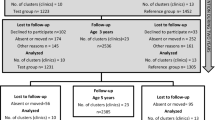Abstract
Aim
Of this prospective cohort study was to assess early childhood caries (ECC) incidence and, based on the data, build a model that not only predicts future ECC onset in clinically caries-free children, but also is prognostic for children with ECC.
Methods
ECC incidence was assessed at the 12-month follow-up examination on a cohort of 291 preschool children. Weighted general estimation equation (WGEE) was used to estimate the effects of covariates on ds (decayed primary tooth surfaces) and dfs (decayed and filled primary tooth surfaces).
Results
The mean dfs at the baseline examination was 0.81. Of the 116 children who completed the study, approximately 22% examined at baseline had ECC (dfs > 0). At 12-months, 36% had ECC with a mean dfs of 2.22. Children with dfs = 0 at baseline had 2.95 fewer ds in the primary dentition at the end of the study than children who had ECC at the baseline examination (dfs > 0) (p < 0.0001). Children with dfs = 0 at baseline had 5.49 fewer ds and dfs in the primary dentition at the end of the study than children who had ECC at the baseline examination (dfs > 0) (p < 0.0001).
Conclusions
ECC incidence at 1 year was 14%. The prevalence of ECC at the 12-month follow-up examination was approximately 36%. The model developed from these data strongly indicate that past caries experience in the primary dentition is a significant predictor of future caries activity and severity, as well as a predictor of future caries onset in clinically caries-free children.
Similar content being viewed by others
References
AAPD. American Academy of Paediatric Dentistry reference manual 2011–2012. Pediatr Dent. 2011;33:1–349.
Acs G, Shulman R, Ng MW, et al. The effect of dental rehabilitation on the body weight of children with early childhood caries. Paediatr Dent. 1999;21:109–13.
al-Shalan TA, Erickson PR, Hardie NA. Primary incisor decay before age 4 as a risk factor for future dental caries. Pediatr Dent. 1997;19:37–41.
Berkowitz RJ. Causes, treatment and prevention of early childhood caries: a microbiologic perspective. J Can Dent Assoc. 2003;69:304–7.
Berkowitz RJ, Turner J, Green P. Maternal salivary levels of Streptococcus mutans and primary oral infection of infants. Arch Oral Biol. 1981;26:147–9.
Boyce WT, Den Besten PK, Stamperdahl J, et al. Social inequalities in childhood dental caries: the convergent roles of stress, bacteria and disadvantage. Soc Sci Med. 2010;71:1644–52.
Broadbent JM, Thomson WM, Williams SM. Does caries in primary teeth predict enamel defects in permanent teeth? A longitudinal study. J Dent Res. 2005;84:260–4.
Casamassimo PS, Thikkurissy S, Edelstein BL, et al. Beyond the dmft: the human and economic cost of early childhood caries. J Am Dent Assoc (1939). 2009; 140:650–7.
Chaffee BW, Gansky SA, Weintraub JA, et al. Maternal oral bacterial levels predict early childhood caries development. J Dent Res. 2014;93:238–44.
Du Q, Yu M, Li Y, et al. (2016). Permanent caries experience is associated with primary caries experience: a 7-year longitudinal study in China. Commun Dent Oral Epidemiol. https://doi.org/10.1111/cdoe.12257.
Dye BA, Tan S, Smith V, et al. (2007). Trends in oral health status: United States, 1988–1994 and 1999–2004. Vital and health statistics. Series 11. Data from the national health survey (248), pp. 1–92.
Dye BA, Thornton-Evans G, Li X, et al. (2015). Dental caries and sealant prevalence in children and adolescents in the United States, 2011–2012. NCHS data brief, pp. 1–8.
Ferguson DJ. Growth of the face and dental arches. In: McDonald RE, Avery DR, Dean JA, editors. Dentistry for the child and adolescent. 8th ed. Philadelphia: CV Mosby Co; 2004.
Ghazal T, Levy SM, Childers NK, et al. Prevalence and incidence of early childhood caries among African–American children in Alabama. J Public Health Dent. 2015;75:42–8.
Guarnizo-Herreno CC, Wehby GL. Children’s dental health, school performance, and psychosocial well-being. J Paediatr. 2012;161:1153–9.
Khan SA, Omar H. Teledentistry in practice: literature review. Telemed J e-health. 2013;19:565–7.
Kopycka-Kedzierawski DT, Billings RJ. Teledentistry in inner-city child-care centres. J Telemed Telecare. 2006;12:176–81.
Kopycka-Kedzierawski DT, Billings RJ. Prevalence of dental caries and dental care utilisation in preschool urban children enrolled in a comparative-effectiveness study. Eur Arch Paediatr Dent. 2011;12:133–8.
Kopycka-Kedzierawski DT, Billings RJ. Comparative effectiveness study to assess two examination modalities used to detect dental caries in preschool urban children. Telemed e-health 2013;19(11):834–40.
Liang KY, Zeger SL. Longitudinal data analysis using generalized linear models. Biometrika. 1986;73:13–22.
Loesche WJ. Role of Streptococcus mutans in human dental decay. Microbiol Rev. 1986;50:353–80.
Marinho VC, Worthington HV, Walsh T, et al. Fluoride varnishes for preventing dental caries in children and adolescents. Cochrane Database Syst Rev. 2013;7: CD002279.
Newacheck PW, Hughes DC, Hung YY, et al. The unmet health needs of America’s children. Paediatrics 2000; 105: 989–997.
O’Sullivan DM, Tinanoff N. The association of early dental caries patterns with caries incidence in preschool children. J Public Health Dent. 1996;56:81–3.
Powell LV. Caries prediction: a review of the literature. Commun Dent Oral Epidemiol. 1998;26:361–71.
Robins JM, Rotnitzky A, Zhao LP. Estimation of regression coefficients when some regressors are not always observed. J Am Stat Assoc. 1994;89:846–66.
Teanpaisan R, Thitasomakul S, Piwat S, et al. Longitudinal study of the presence of mutans streptococci and lactobacilli in relation to dental caries development in 3–24 month old Thai children. Int Dent J. 2007;57:445–51.
Weintraub JA, Ramos-Gomez F, Jue B, et al. Fluoride varnish efficacy in preventing early childhood caries. J Dent Res. 2006;85:172–6.
Acknowledgements
This research was supported by NIH/NIDCR K23 DE 017230.
Author information
Authors and Affiliations
Corresponding author
Ethics declarations
Ethical approval
All procedures performed in studies involving human participants were in accordance with the ethical standards of the institutional and/or national research committee and with the 1964 Helsinki declaration and its later amendments or comparable ethical standards.
Rights and permissions
About this article
Cite this article
Kopycka-Kedzierawski, D.T., Billings, R.J. & Feng, C. Development of a prognostic model for caries onset and progression from early childhood caries incidence in urban preschool children. Eur Arch Paediatr Dent 20, 303–309 (2019). https://doi.org/10.1007/s40368-018-0404-2
Received:
Accepted:
Published:
Issue Date:
DOI: https://doi.org/10.1007/s40368-018-0404-2




